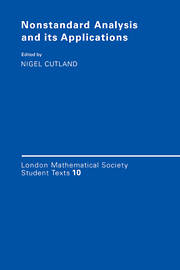Book contents
- Frontmatter
- Contents
- Preface
- Contributors
- AN INVITATION TO NONSTANDARD ANALYSIS
- INFINITESIMALS IN PROBABILITY THEORY
- INFINITESIMALS IN FUNCTIONAL ANALYSIS
- APPLICATIONS OF NONSTANDARD ANALYSIS IN MATHEMATICAL PHYSICS
- A LATTICE FORMULATION OF REAL AND VECTOR VALUED INTEGRALS
- AN APPLICATION OF NONSTANDARD METHODS TO COMPUTATIONAL GROUP THEORY
- SYNTACTICAL METHODS IN INFINITESIMAL ANALYSIS
- SOME ASYMPTOTIC RESULTS IN ORDINARY DIFFERENTIAL EQUATIONS
- SUPERINFINITESINALS AND INDUCTIVE LIMITS
- THE NON-LINEAR BOLTZMANN EQUATION FAR FROM EQUILIBRIUM
- INDEX
AN APPLICATION OF NONSTANDARD METHODS TO COMPUTATIONAL GROUP THEORY
Published online by Cambridge University Press: 05 June 2012
- Frontmatter
- Contents
- Preface
- Contributors
- AN INVITATION TO NONSTANDARD ANALYSIS
- INFINITESIMALS IN PROBABILITY THEORY
- INFINITESIMALS IN FUNCTIONAL ANALYSIS
- APPLICATIONS OF NONSTANDARD ANALYSIS IN MATHEMATICAL PHYSICS
- A LATTICE FORMULATION OF REAL AND VECTOR VALUED INTEGRALS
- AN APPLICATION OF NONSTANDARD METHODS TO COMPUTATIONAL GROUP THEORY
- SYNTACTICAL METHODS IN INFINITESIMAL ANALYSIS
- SOME ASYMPTOTIC RESULTS IN ORDINARY DIFFERENTIAL EQUATIONS
- SUPERINFINITESINALS AND INDUCTIVE LIMITS
- THE NON-LINEAR BOLTZMANN EQUATION FAR FROM EQUILIBRIUM
- INDEX
Summary
INTRODUCTION
The methodological background of this paper is the theory of rewrite rules, although it is never mentioned explicitly. Finite complete sets of rewrite rules for a finitely presented algebra solve a number of decision problems for this algebra such as the word problem, the finiteness problem or the existence of a nilpotent subgroup of finite index. These problems remain solvable also for many infinite complete systems; what really matters is that the irreducible words form a regular set in the sense of automata theory. The regularity of the set of irreducible words can be regarded as an asymptotic aspect of the so-called Knuth-Bendix completion procedure. This is connected with an ordering on the words and some of these orderings are the central subject of our investigation. For more information on these topics we refer, for example to Benninghofen, Kemmmerich & Richter (1987) or to Richter (1987). In Richter (1987) one finds also a proof of the main result of this paper in a much more restricted case.
The main result can be found in section 4 and shows the non-regularity of the minimal words of the free nilpotent group of class 2 for a certain set of widely used orderings. We study a nonstandard model of this group (which was introduced in van den Dries & Wilkie (1984) in the context of Gromov's theorem) and its nonstandard hull and use a connection with the growth function of the group and with (nonstandard) automata theory.
- Type
- Chapter
- Information
- Nonstandard Analysis and its Applications , pp. 237 - 257Publisher: Cambridge University PressPrint publication year: 1988



